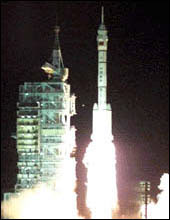 China saluted the 21st century by launching its second unmanned spacecraft, "Shenzhou II", at the early hours of Wednesday, marking a new progress in the country's space program.
China saluted the 21st century by launching its second unmanned spacecraft, "Shenzhou II", at the early hours of Wednesday, marking a new progress in the country's space program.
Chinese President Jiang Zemin sent a congratulatory message to hail the successful launch and convey his greetings to the scientists, cadres, workers, and People's Liberation Army servicemen involved in the manufacture and launch of the unmanned spacecraft.
It was a chilly morning, with a temperature of minus 13 centigrade degrees, at the Jiuquan Satellite Launching Center, in the northwest.
The launching center conducted the launching of China's first satellite, on April 24, 1970; first long-distance rocket carrier, on May 18, 1980; and first unmanned spacecraft, "Shenzhou I", on November 20.
"Shenzhou II", though carrying no astronaut, adopts the technology and equipment designed for manned space shuttles, such as the escaping system on its top allowing astronauts to use under emergent circumstances.
In fact, a number of special "passengers" are riding the space vehicle, including animals and microbial cells provided by the Chinese Academy of Sciences. These "passengers" are expected to join a series of experiments in the space, which will be the first kind of such tests carried out by Chinese scientists.
As it is also the first time for the launching center to carry out a mission in deep winter days, experts had conducted three low-temperature tests before the launching of "Shenzhou II".
Propellant in the rocket carrier calls for strict temperature conditions, according to the experts. The center has developed a special temperature-controlling system for the propellant.
A greet signal bullet shot up into the sky, when the commander ordered to start the 30-minute preparation. People began to withdraw from the launching pad.
As the time of projection drew near, the whole launching center fell into a calmness.
"10, 9, 8, 7, 6, 5, 4, 3, 2, 1, ignition." The rocket carrier roared, took off and sped into the sky, while ejecting dazzling flames. It was 01:00 hour (Beijing time).
In the controlling center, people gazed at the large screen to see that the red real flight route of the rocket was overlapping the theoretic flight course.
The rocket carrying "Shenzhou II" was flying above the Pacific Ocean, where "Yuanwang", the monitoring vessel, was closely following the track of the rocket.
At 01:10 hours, the rocket carrier departed from the spacecraft as Shenzhou II entered the preset orbit, beginning its space voyage.
(Xinhua 01/10/2001)
